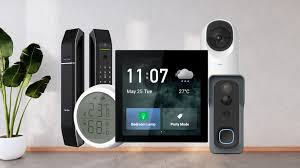Introduction
The concept of a “smart home” has evolved from science fiction to reality, thanks to the rapid advancement of smart home devices. These internet-connected gadgets offer convenience, security, efficiency, and personalization, redefining how we interact with our living spaces.
From controlling lights with your voice to monitoring home security from your phone, smart home devices are making homes more intelligent, connected, and user-centric than ever before.
What Are Smart Home Devices?
Smart home devices are electronic systems connected through a network—usually Wi-Fi or Bluetooth—that allow remote access and automation. They can be controlled via:
-
Voice commands (e.g., Alexa, Google Assistant, Siri)
-
Mobile apps
-
Automated routines and triggers
These devices often work within larger home automation ecosystems, enabling them to communicate and work together seamlessly.
Benefits of Smart Home Devices
1. Convenience
Control lights, locks, thermostats, and appliances from anywhere using your smartphone or voice.
2. Energy Efficiency
Smart thermostats and lighting can reduce energy usage by automating based on your schedule or occupancy.
3. Enhanced Security
Smart cameras, doorbells, and locks provide real-time surveillance and alerts, boosting home safety.
4. Cost Savings
Lower energy bills, reduced water usage, and preventative maintenance (e.g., leak detectors) help save money in the long run.
5. Accessibility
Smart homes benefit people with disabilities or limited mobility by offering hands-free control and automation.
Popular Categories of Smart Home Devices
🔊 1. Smart Speakers & Assistants
-
Amazon Echo, Google Nest, Apple HomePod
-
Serve as central hubs for controlling other smart devices
-
Play music, answer queries, manage reminders, and more
💡 2. Smart Lighting
-
Philips Hue, LIFX, Wyze Bulb
-
Schedule on/off times, change colors, dim lights
-
Sync with music, movies, or alarms
🌡️ 3. Smart Thermostats
-
Google Nest Thermostat, Ecobee, Honeywell
-
Learn user behavior and adjust heating/cooling accordingly
-
Monitor energy use and provide cost-saving suggestions
🔐 4. Smart Locks & Doorbells
-
August Smart Lock, Ring Video Doorbell, Arlo
-
Control and monitor door access remotely
-
View visitors, get alerts, and even communicate in real-time
📷 5. Smart Cameras & Security Systems
-
Blink, Eufy, SimpliSafe
-
Real-time video streaming, motion detection, night vision
-
Store footage locally or in the cloud
🧼 6. Smart Appliances
-
Samsung SmartThings, LG ThinQ, GE Smart Ovens
-
Smart refrigerators, washing machines, robotic vacuum cleaners
-
Automate tasks and receive maintenance alerts
🚿 7. Smart Plugs and Outlets
-
TP-Link Kasa, Amazon Smart Plug
-
Turn regular devices smart
-
Schedule appliances, monitor energy usage
Smart Home Ecosystems
These are platforms that allow integration and management of multiple smart devices from a single interface:
| Ecosystem | Compatible Assistants | Key Features |
|---|---|---|
| Amazon Alexa | Echo, Fire TV | Broad device compatibility, routines |
| Google Home | Nest Hub, Android | Voice control, contextual responses |
| Apple HomeKit | iPhone, iPad, Siri | Strong privacy, deep iOS integration |
| Samsung SmartThings | Samsung TVs, apps | Automation, sensors, smart appliances |
Setup and Integration Tips
-
Start Small: Begin with a smart speaker or smart plug to get familiar.
-
Check Compatibility: Ensure all devices support your preferred ecosystem.
-
Secure Your Network: Use strong passwords and enable two-factor authentication.
-
Group Devices: Organize by room or type for easy access.
-
Automate: Create routines like “Good Morning” to automate lights, blinds, and coffee makers at once.
Security and Privacy Considerations
While smart home devices offer convenience, they also raise concerns:
-
Data Collection: Some devices collect usage and location data.
-
Hacking Risks: Connected devices can be entry points for cyber threats.
Best practices:
-
Keep firmware updated
-
Use a separate network (guest Wi-Fi) for smart devices
-
Disable unused features like remote access when not needed
The Future of Smart Homes
As AI and machine learning evolve, smart home devices will become more predictive and personalized:
-
AI assistants that anticipate needs
-
Energy grids that optimize based on usage
-
Home robots performing complex tasks
Integration with 5G and IoT ecosystems will further accelerate responsiveness and cross-device communication.
Final Thoughts
Smart home devices are redefining modern living—offering unmatched control, convenience, and peace of mind. Whether you’re building a high-tech home or simply want to automate your lights or thermostat, there’s a smart solution for everyone.
By choosing the right devices, staying secure, and setting up smart automation routines, your home can become more efficient, comfortable, and responsive to your lifestyle.







